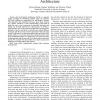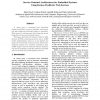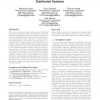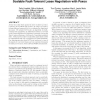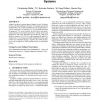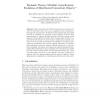HASE
2007
IEEE
14 years 5 months ago
2007
IEEE
—Service-Oriented Architecture (SOA) is a popular design paradigm for distributed systems today. Its dynamics and loose coupling are predestined for self-adaptive systems. This a...
COMPSAC
2007
IEEE
14 years 5 months ago
2007
IEEE
Building open distributed systems is an even more challenging task than building distributed systems, as their components are loosely synchronised, can move, become disconnected, ...
AINA
2007
IEEE
14 years 5 months ago
2007
IEEE
In recent years a movement from distributed systems controlled by users to automatic, autonomous and self-configuring distributed systems is noticeable. Web services is one approa...
HPDC
2008
IEEE
14 years 6 months ago
2008
IEEE
Ever more scientists are employing large-scale distributed systems such as grids for their computational work, instead of tightly coupled high-performance computing systems. Howev...
HPDC
2008
IEEE
14 years 6 months ago
2008
IEEE
A lease is a token which grants its owner exclusive access to a resource for a defined span of time. In order to be able to tolerate failures, leases need to be coordinated by di...
ETFA
2008
IEEE
14 years 6 months ago
2008
IEEE
The distribution of real-time tasks in a networked environment in principle has several advantages, above all a high degree of flexibility easing system extension and replacement...
EICS
2009
ACM
14 years 6 months ago
2009
ACM
Adaptive groupware systems support changes in users’ locations, devices, roles and collaborative structure. Developing such systems is difficult due to the complex distributed ...
ICHIT
2009
Springer
14 years 6 months ago
2009
Springer
Middleware facilitates the development of distributed systems by accommodating heterogeneity, hiding distribution details and providing a set of common and domain specific service...
FM
2009
Springer
14 years 6 months ago
2009
Springer
Abstract. Many long-lived and distributed systems must remain available yet evolve over time, due to, e.g., bugfixes, feature extensions, or changing user requirements. To facilit...
P2P
2009
IEEE
14 years 6 months ago
2009
IEEE
Distributed systems such as Peer-to-Peer overlays have been shown to efficiently support the processing of range queries over large numbers of participating hosts. In such system...
